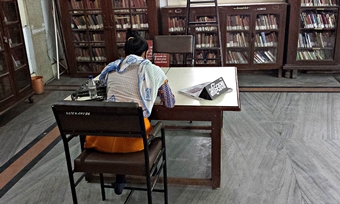
Excerpt from “TRAVELS THROUGH GUJARAT, DAMAN, AND DIU” by Adam YAMEY. Available as a Kindle from Amazon and as a paperback from lulu.com, amazon.com, and bookdepository.com
The Watson Museum in Rajkot has a good collection of exhibits that encompass the history of the area around Rajkot. Given its age, it is in good condition, and well-worth visiting as is its neighbour in another part of the same building, the Lang Library. It was founded in 1856 by Colonel William Lang, who was a British Political Agent in the Kathiawar region of India, which included Rajkot, from 1846 to ’59. Today, it is named the Arvindbhai Maniyar Library in honour of a former Mayor of Rajkot.
Before entering the spacious reading room, we saw a glass case containing a model depicting the Hindu goddess of knowledge, music, arts, and wisdom, Saraswati, holding a stringed musical instrument in her raised left hand. She was draped with flower garlands. The reading room, surrounded by bookcases and busts of famous people, has many tables and chairs. Almost every chair was occupied by men reading newspapers. Part of the ceiling is made in shiny wood (like a parquet floor) patterned with lozenges containing centrally placed carved wooden rosettes. An elegant staircase with curved wooden bannisters leads to an upper floor. A side room on the ground floor serves a children’s library equipped with miniature desks whose seatbacks are carved to resemble squirrels in profile.
On our way out of the library, we noticed a small table with only enough room for two chairs. It bore a notice in Gujarati saying that it was “reserved for female readers”. One of the chairs was occupied by a young lady, who confirmed that this table is the only place allotted to female readers. When asked what happened when there were more than two female readers, she shrugged her shoulders, and said: “There never are.” The segregation of library users by gender is one of many indications we had that people in Saurashtra retain very conservative views of how life should be lived.
